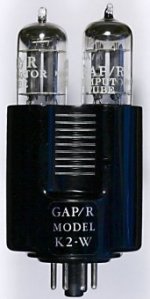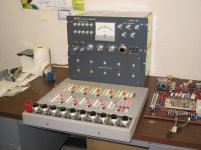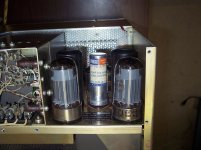Completely agreed. And sometimes it is horrible.
And sometimes you really need the isolation. I did an American Football Stadium. The control room is high on the 50 yd line the amplifiers are ground level outside the end zone (1/4 turn around and all the up and down you want). To get the S/N to where you could not here noise at the field level 50 m-ish I had to use transformers on the send and receive ends! (Electronic balanced was tried and did not work even with a single transformer.) Yes it was 2 conductor shielded wire between the 2. Actually 6 pair cable, but I don't think there was an overall shield. It was foil not woven shield.
But that is not exactly high end high fidelity gear.
Hi Simon,
Glanced over your schematic and my eye got caught by U5. I might be missing something, but should inverting input of U5 not be also connected to ground through resistor, like R16 in the case of U6?
Vac
Not required. R3, R6, R9, R12 through C2 provide the load to R14/C25. At the 1000 hz operating frequency it is about 700 ohms.
R16 probably could go away!
I am not saying one does not need an isolation. In fact any signal should be isolated. It is nice when we can convert them to something than can be transferred through optical fibre. This is the only ISOLATION.
Pavel,
I tuned up another NFL American Football Stadium. Even outdoors the digital signal processor and fiber optic transfer system did not sound very good. Until "Pro" audio links improve I will stick with analog!
Last year's arena, I was heading up to the amplifier room with a portable CD player to test some stuff. One of the college kids looked at my CD player and commented "Wow... Retro." I don't think I am ready to check out a system with MP3's yet!
Not required. R3, R6, R9, R12 through C2 provide the load to R14/C25. At the 1000 hz operating frequency it is about 700 ohms.
R16 probably could go away!
Yes, was too fast posting, after looking at it againt it is more the other way around. No reason to have high pass filter with including phase shift at this location.
Good paper Scott, thanks.
What struck me is the style of drawing the opamp symbol as well as the general drawing style. It reminds me of the books, articles and app notes by Gerald Graeme, one of the last analog guru's of Burr-Brown. Was there a connection between ADI and him?
jan didden
They both harken back to George Philbrick AFAIK, I wish some of their analog computing books were available on line.
A picture is still worth a few posts. The problem has been dealt with in printing images for years. The difference with and without something like error diffusion dithering in a quantized image is pretty obvious.
http://www.cs.princeton.edu/courses/archive/fall00/cs426/lectures/dither/dither.pdf
That's excellent Scott.
They both harken back to George Philbrick AFAIK, I wish some of their analog computing books were available on line.
Well thanks to guys like Bob Pease and Jim Williams there is a record of much of this early literature. Put aside the acrimony for a few hours and check this timeless stuff out.
The Philbrick Archive
Scott,
Thanks for this great link, I will have hours of pleasure reading it.
Great illustration on the front page. Just wait till the tube guys find out an opamp may look like something like this.

They will go nuts and have their time machines spinning before you know it.
vac
Thanks for this great link, I will have hours of pleasure reading it.
Great illustration on the front page. Just wait till the tube guys find out an opamp may look like something like this.

They will go nuts and have their time machines spinning before you know it.
vac
Attachments
A partial history of analog computing.
Back in the 1950's analog computing was the best way to solve many engineering problems, especially those that contained differential equations. Different states of 'motion' could be generated, including velocity, acceleration, damping, etc.
By about 1962, digital computers apparently caught up to solving these problems, as well as their traditional tasks, by using an analog emulator. In fact, Heathkit actually made an analog computer kit, and I borrowed one over the summer of 1962, and was able to emulate an oscillator, etc.
By 1963, when I was operating the IBM 7094 digital computer for Lockheed Burbank, I passed a room full of analog computers, with lots of serious people involved in their operation. Later, I suspect that they were 'phased out' due to the remarkable improvements in digital computers. By 1966, I didn't find any analog computers at Friden Inc, where I started to work, after graduation. We just used ECAP to emulate circuits directly, using AC, DC and Transient analysis. I suspect, that except for special applications, analog computers were essentially obsolete. They would not be necessarily very fast, either. After, all their output would probably be recorded with a pen recorder of some kind, or looked at on an oscilloscope running rather slowly. Slew rate limiting might be possible, but not fundamental to the operation.
However, there was a lot then learned about PASSIVE components, especially capacitors, in the early work with analog computers. This is where the equivalent circuit for dielectric absorption was derived, EVEN for polystyrene caps, as this was the minimum material necessary for accurate operation. This cap DA model was later used by Bob Pease in his DA paper, but it was derived in the early 1950's.
The analog computer CONCEPT was elegant, and extremely enlightening, but today, brute force digital computing is faster and more accurate for most simulations.
Back in the 1950's analog computing was the best way to solve many engineering problems, especially those that contained differential equations. Different states of 'motion' could be generated, including velocity, acceleration, damping, etc.
By about 1962, digital computers apparently caught up to solving these problems, as well as their traditional tasks, by using an analog emulator. In fact, Heathkit actually made an analog computer kit, and I borrowed one over the summer of 1962, and was able to emulate an oscillator, etc.
By 1963, when I was operating the IBM 7094 digital computer for Lockheed Burbank, I passed a room full of analog computers, with lots of serious people involved in their operation. Later, I suspect that they were 'phased out' due to the remarkable improvements in digital computers. By 1966, I didn't find any analog computers at Friden Inc, where I started to work, after graduation. We just used ECAP to emulate circuits directly, using AC, DC and Transient analysis. I suspect, that except for special applications, analog computers were essentially obsolete. They would not be necessarily very fast, either. After, all their output would probably be recorded with a pen recorder of some kind, or looked at on an oscilloscope running rather slowly. Slew rate limiting might be possible, but not fundamental to the operation.
However, there was a lot then learned about PASSIVE components, especially capacitors, in the early work with analog computers. This is where the equivalent circuit for dielectric absorption was derived, EVEN for polystyrene caps, as this was the minimum material necessary for accurate operation. This cap DA model was later used by Bob Pease in his DA paper, but it was derived in the early 1950's.
The analog computer CONCEPT was elegant, and extremely enlightening, but today, brute force digital computing is faster and more accurate for most simulations.
Last edited:
A partial history of analog computing.
Back in the 1950's analog computing was the best way to solve many engineering problems, especially those that contained differential equations. Different states of 'motion' could be generated, including velocity, acceleration, damping, etc.
By about 1962, digital computers apparently caught up to solving these problems, as well as their traditional tasks, by using an analog emulator. In fact, Heathkit actually made an analog computer kit, and I borrowed one over the summer of 1962, and was able to emulate an oscillator, etc.
By 1963, when I was operating the IBM 7094 digital computer for Lockheed Burbank, I passed a room full of analog computers, with lots of serious people involved in their operation. Later, I suspect that they were 'phased out' due to the remarkable improvements in digital computers. By 1966, I didn't find any analog computers at Friden Inc, where I started to work, after graduation. We just used ECAP to emulate circuits directly, using AC, DC and Transient analysis. I suspect, that except for special applications, analog computers were essentially obsolete. They would not be necessarily very fast, either. ....
The analog computer CONCEPT was elegant, and extremely enlightening, but today, brute force digital computing is faster and more accurate for most simulations.
John, I was not aware of analog computing history that well since it was slightly before my time, but if it is up to me, it may be coming back with a vengeance. Albeit in an altered form. The reason is that brute force digital computing suffers from a "chess board" problem. With each variable you introduce that needs to be correlated to all other variables, the number of calculations increases exponentially. Soon you will run out of grains of rice. Analog computing seems to avoid this. I recently finished a project in which 16 simple processors where connected in a network. Each processor performed some relatively simple calculations on a limited number of inputs, much like the building blocks for analog computing I found in the link you sent earlier. The only difference being that in my setup, these building blocks communicate through PWM signals, rather than analog ones. The result is a processing centre that combines the inputs of 6 different motion sensors and 6 manual inputs into controls for 12 servo's in total. This whole processing centre fits in a 2" cube, using about 2 Watts of power. Brute force number crunching could have worked, but would have required some pretty heavy computing.
vac
Hi,
Funny, eastern europe was quite strong on analogue computers and retained them much longer than the west (things rarely got replaced until they where at least two generations out of date or totally broken), so it was in my time.
The stuff that was really seriously cooking used analogue computers for speed to give near instant "close enough" solutions to complex differential equations and digital computers to calculate in fairly quick time the required additional precision.
Some of this stuff was still in use in the 80's, especially in military and industrial systems and combined a speed and accuracy not seen at the time in the west in the public domain (may very well have been exceeded in mil-spec stuff), BUT is was much bulkier and more fragile than the west's all digital systems, largely because the technology had been mostly abandoned in the 70's and never got shifted to complex analog IC's and digital LSI.
Sadly all this knowledge is lost, or mostly so as is the gear, so it seems we have to reinvent the wheel (again). With Modern GHz capable analogue cells such hybrids may be quite interesting for certain applications.
Ciao T
John, I was not aware of analog computing history that well since it was slightly before my time
Funny, eastern europe was quite strong on analogue computers and retained them much longer than the west (things rarely got replaced until they where at least two generations out of date or totally broken), so it was in my time.
The stuff that was really seriously cooking used analogue computers for speed to give near instant "close enough" solutions to complex differential equations and digital computers to calculate in fairly quick time the required additional precision.
Some of this stuff was still in use in the 80's, especially in military and industrial systems and combined a speed and accuracy not seen at the time in the west in the public domain (may very well have been exceeded in mil-spec stuff), BUT is was much bulkier and more fragile than the west's all digital systems, largely because the technology had been mostly abandoned in the 70's and never got shifted to complex analog IC's and digital LSI.
Sadly all this knowledge is lost, or mostly so as is the gear, so it seems we have to reinvent the wheel (again). With Modern GHz capable analogue cells such hybrids may be quite interesting for certain applications.
Ciao T
I saw some of the Philbrick opamps on ebay being sold as dual sockets w/o tubes!
Heresy! Those opamps are real diff-in diff-out circuits, re-invented decades later by the audio crowd:
http://www.linearaudio.nl/K2-X-1.htm
jan didden
@jneutron
What a beauty. Is that red plug for emergencies when smoke or sizzling sounds emerge?
vac
If it is....it didn't work. I had this unit in order to refurbish it. Spent a week reforming the caps very slowly with a variac...two of them did not awaken in a good mood..too dry. I will admit however, that I (for a change) was very intelligent in how I worked on the unit. The first thing I did was take pictures of every single wire, component, connection, in every location on the unit. I could read all the color codes, trace all the wires, just from the pictures. Not normal electronic troubleshooting of course, but I was unable to obtain schematics. When several resistors in the power supply burned and obliterated the color codes, I just "went back to the video tape".
No, I am not missing them at all.Aren't you missing the 3410 & 3420?
But I did learn a lot about electrolytics, aging, and reforming.
Here's the culprit..that 20/20.. tried to upload two more guts pics, they failed..size I believe.
OH..almost forgot..lower left side, notice those cartridge rectifiers?? I had never seen anything like that before..neat..
Cheers, John
Attachments
Last edited:
A partial history of analog computing.
Back in the 1950's analog computing was the best way to solve many engineering problems, especially those that contained differential equations. Different states of 'motion' could be generated, including velocity, acceleration, damping, etc.
By about 1962, digital computers apparently caught up to solving these problems, as well as their traditional tasks, by using an analog emulator. In fact, Heathkit actually made an analog computer kit, and I borrowed one over the summer of 1962, and was able to emulate an oscillator, etc.
By 1963, when I was operating the IBM 7094 digital computer for Lockheed Burbank, I passed a room full of analog computers, with lots of serious people involved in their operation. Later, I suspect that they were 'phased out' due to the remarkable improvements in digital computers. By 1966, I didn't find any analog computers at Friden Inc, where I started to work, after graduation. We just used ECAP to emulate circuits directly, using AC, DC and Transient analysis. I suspect, that except for special applications, analog computers were essentially obsolete. They would not be necessarily very fast, either. After, all their output would probably be recorded with a pen recorder of some kind, or looked at on an oscilloscope running rather slowly. Slew rate limiting might be possible, but not fundamental to the operation.
However, there was a lot then learned about PASSIVE components, especially capacitors, in the early work with analog computers. This is where the equivalent circuit for dielectric absorption was derived, EVEN for polystyrene caps, as this was the minimum material necessary for accurate operation. This cap DA model was later used by Bob Pease in his DA paper, but it was derived in the early 1950's.
The analog computer CONCEPT was elegant, and extremely enlightening, but today, brute force digital computing is faster and more accurate for most simulations.
Hi John,
Good points about analog computers. I had a friend who worked at Electronic Associates (EAI) on analog computers and he was very much into the dielectric absorption problem for the capacitors used in the integrators. To the best of my knowledge, all of the DA models were linear, with component values that were not a function of frequency.
Interestingly, when I was at RPI we had a great lab on analog computers, but the school did not always have enough of the analog computers to satisfy the needs of the many students. So someone wrote a program called "Digitsim" that emulated the analog computer on the IBM360.
Cheers,
Bob
- Status
- Not open for further replies.
- Home
- Member Areas
- The Lounge
- John Curl's Blowtorch preamplifier part II


